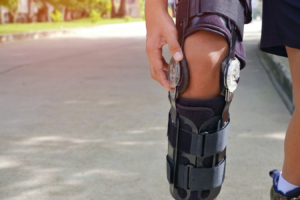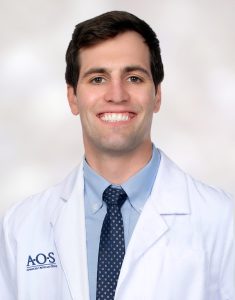Unfortunately, knee injuries are incredibly common, especially for athletes. The most feared among them are undoubtedly ACL and MCL tears. Either injury could sideline an athlete for months or even worse – an entire season. Both the ACL and MCL ligaments support knee stabilization, and if they are injured they can result in pain, swelling, and difficulty walking. While an ACL tear and MCL tear have some similarities and may even sound alike, they are actually very different. So, what exactly is the difference between an ACL tear and an MCL tear? Learn all this and more in the following post.
 What is the ACL?
What is the ACL?
The ACL, or the anterior cruciate ligament, lies in the center of the knee connecting the femur to the tibia. This ligament keeps the shinbone from sliding forward, resulting in the knee giving way or buckling.
 What is the MCL?
What is the MCL?
The MCL, or the medial collateral ligament, resides on the inside of the knee; keeping it from bending too far inward. The MCL brings stability to the knee, while also allowing the knee to rotate to a certain degree.
How does an ACL injury occur?
An ACL injury may be the result of a sudden stop or change in direction, like pivoting during basketball, sidestepping during football, or quick dribbling during soccer. When the ACL tears, athletes may hear a pop. Additionally, they may not be able to bear weight on the knee, and there is almost always swelling.
How does an MCL injury occur?
However, an MCL injury most often happens to athletes who compete in direct contact sports, like hockey, football, rugby, or wrestling. To clarify, the knee may take a direct hit from the outside, bend too far inward, and cause a strain or tear in the MCL. After the initial hit, the athlete may feel like their knee has a catch in it accompanied by pain and swelling.
How bad is my ACL or MCL injury?
ACL and MCL injuries differ in how they occur. However, they are diagnosed similarly. Both injuries are graded in three phases. Of course, we always recommend seeing a specialist to determine the grade of your injury. A grade one ACL or MCL injury is thought of as a sprain, where the ligament is stretched, but not torn. The knee will be tender, but some time off with icing and elevation should allow the ligament to heal. With a grade two injury, there is noticeable looseness in the knee with pain and swelling. This could be described as a partial tear to one of the ligaments in the knee. Grade three injuries are obviously the worst type, being a complete tear in either the ACL or MCL. With a grade three injury, the knee will no longer feel stable and there will be extreme pain. Additionally, it may require surgery.
 How does healing differ between an ACL injury and an MCL injury?
How does healing differ between an ACL injury and an MCL injury?
Due to the high blood supply to the exterior of the knee, conservative treatment is most common for MCL injuries. Rest and an immobilizing brace should allow the ligament to start its healing process. Physical therapy to restabilize the knee is recommended once the initial pain and swelling have gone down. If the tear is bad enough that the patient needs surgery, it is minimally invasive and quick – only requiring one small incision. A grade one MCL injury may require up to one month of recovery, while grade two or three may require two to three months of recovery time.
Grade one ACL tears will heal with conservative treatments: an immobilizing brace, rest, and physical therapy. This level of injury should heal itself through time. Grade two and three ACL tears may require surgery to reconstruct the ligament. After surgery, a brace and physical therapy to regain range of motion in the knee will still be required. Recovery time for grade one ACL injuries can be four to six weeks, while grade two or three injuries can require a recovery time of six to nine months. Athletes with grade two and three ACL injuries should not resume their normal activities until a doctor releases them to do so.
When should I talk to a doctor?
Injuries that go without treatment can lead to more extreme injuries further down the road, leading to prolonged recovery times or the inability to play sports at all. Therefore, seeing a doctor quickly to determine the level and area of injury is necessary, especially in athletes. Dr. Christopher Cook is a board-certified orthopedic surgeon and sports medicine and joint replacement specialist who frequently treats these injuries.
 Dr. Christopher Cook is a Board-Certified Orthopaedic Surgeon and Sports Medicine & Joint Replacement Specialist at Advanced Ortho and Spine. He provides a full spectrum of Joint Replacement, Sports Medicine, and Shoulder & Upper Extremity services. Contact us today for more information or to request an appointment. Contact us today for more information or to request an appointment.
Dr. Christopher Cook is a Board-Certified Orthopaedic Surgeon and Sports Medicine & Joint Replacement Specialist at Advanced Ortho and Spine. He provides a full spectrum of Joint Replacement, Sports Medicine, and Shoulder & Upper Extremity services. Contact us today for more information or to request an appointment. Contact us today for more information or to request an appointment.
 Dr. Daniel Hagaman is a Fellowship-Trained Orthopaedic Surgeon & Sports Medicine Specialist at Advanced Ortho and Spine. He specializes in a range of orthopaedic conditions and treatments including Knee Arthroscopy, Knee Ligament & Cartilage Repair, Shoulder Arthroscopy, Hip Arthroscopy, Orthobiologistics, and more. Contact us today for more information and to request an appointment.
Dr. Daniel Hagaman is a Fellowship-Trained Orthopaedic Surgeon & Sports Medicine Specialist at Advanced Ortho and Spine. He specializes in a range of orthopaedic conditions and treatments including Knee Arthroscopy, Knee Ligament & Cartilage Repair, Shoulder Arthroscopy, Hip Arthroscopy, Orthobiologistics, and more. Contact us today for more information and to request an appointment.

With two locations near Nashville in Mt. Juliet and Hermitage, Advanced Ortho and Spine provides patients with high-quality, personalized care while advancing orthopaedic excellence. Contact us today to learn more or to schedule your appointment.
Disclaimer: This blog provides general information and discussions about health and related subjects. The information and other content provided in this blog, or in any linked materials, are not intended and should not be construed as medical advice, nor is the information a substitute for professional medical expertise or treatment.If you or any other person has a medical concern, you should consult with your healthcare provider or seek other professional medical treatment. Never disregard professional medical advice or delay in seeking it because of something read on this blog or in any linked materials. If you think you may have a medical emergency, call your doctor or emergency services immediately.
The opinions and views expressed on this blog and website have no relation to those of any academic, hospital, health practice, or other institution.

